Leverage your company’s content marketing strategy with evergreen articles to drive more traffic to your blog
Your company’s blog is a powerful tool that is not correctly being utilized if it lacks evergreen content.
Most people are unaware that the majority of blog posts fall under two main categories, evergreen content being one of them. With that said, your current company articles do fall under either of the two, you just do not know it.
When unaware of the purpose of the content you create, it is impossible to know how to use it to your benefit.
Download our Free Resource – Top 10 common content marketing mistakes
Our free content marketing mistakes guide reveals the most common mistakes, but more importantly, what to do about them. It highlights auditing tools, strategy recommendations and examples.
Access the
Learning how to write evergreen blog content that will rank on Google is essential to leveraging your digital marketing strategy.
Every second, 67,000 searches are performed on Google, making your blog’s content extremely important. Understanding the difference between the two main categories is best when wanting to produce content that provides results.
You may think that all blog posts are equal and remain relevant once they are published online, but this is not the case. Evergreen content is different. To understand why, you must become familiar with the other main content category, which is, time-sensitive content.
1.Two main writing categories
- Time-sensitive content
- Evergreen content
Both of the main writing categories are essential to SEO (Search Engine Optimization), as they both play their part.
To use your company’s blog to its fullest extent and for it to rank high on Google, it is vital you know why each blog content category is necessary.
What is time-sensitive content?
Simply put, time-sensitive blog posts or articles include content with expiration dates. Some of the subject matter covered can be, news, updates, and trends.
If the content your company writes about has a date or features an item that changes often, then you are writing time-sensitive content.
Time-sensitive topics only last for a short while before something new comes along and takes its place, making the "buzz" around the subject short-lived. Eventually, the relevancy of the content no longer exists.
Types of time-sensitive content
- Pop culture
- Current trends
- Dated statistics
- Timely reports
- Case studies that quickly go out of date
- Current fashion trends
- Features or algorithm updates
- New social networks or software
- New product releases
- Event-related
Although time-sensitive content is brief, it is still needed for your blog’s SEO and to improve your Google ranking.
Why is time-sensitive content important for SEO?
The purpose of SEO is to work towards getting your content on the first page of Google. The better your company’s content performs, the higher it will rank on this popular search engine.
Where your content ranks on Google determines how easily readers can find your company's blog posts or not. The higher your blog’s Google ranking, the better, as it increases the chances of it appearing on the first Search Engine Results Page (SERP) on Google.
The purpose of time-sensitive content is to have your company’s blog become among the first to deliver breaking news and to make big announcements. If successful, your time-sensitive content will be what grabs the attention of readers first, ultimately, driving a great deal of traffic to your blog at one time.
The likelihood of social signals increasing (likes, shares, comments) is high. These signals are what tells Google that people like and recommend your content. This makes you an authoritative site, which raises your Google ranking
Remember, this spike in visitors does not last long, hence the name, 'time-sensitive'. This type of content is limiting and loses its value quickly. This is why you need to include evergreen content into your strategy to receive long-lasting results.

What is evergreen content?
Evergreen content is the opposite of time-sensitive, as it does not have an expiration date attached to it. It is more of a long-term type strategy than when using time-sensitive articles.
Evergreen content brings visitors to your blog over and over again. It will never become outdated or irrelevant, but time-sensitive content, on the other hand, will.
A good analogy to help you remember the purpose of evergreen content is to think of it being like a flourishing forest. One that is filled with sustainable green plants that offer its inhabitants the resources of long-term living.
Now imagine the forest to be your blog and the plants, evergreen content. People often use this type of content as a resource and it can be referenced long after it was initially published. It is the content that never ends, it goes on and on.
Ultimately, it is what makes your company's blog a "hub" of content. Evergreen posts continually hold their value no matter how much time passes.
Types of evergreen content
- Listicles
- Tips
- How-tos
- Product reviews
- Surveys
- Step-by-step guides/tutorials
- Frequently Asked Questions (FAQ)
- Educational
- Advice giving
Your blog requires evergreen content, not only for longevity and relevancy with readers but search engines, too. If people like your evergreen content, Google will love it too.
As it is timeless, it remains useful and does not go "out of style," leading to a cycle of visitors.
The evergreen content cycle
High search engine rankings = increase in traffic = continuing to generate leads.
The more evergreen content you write, the more this cycle will continue to grow and continue.
2. How to write evergreen content
To produce evergreen content that will rank on Google, there are three essential steps you must follow to increase your Google ranking.
Evergreen relatable content topics
When considering what topics to write about, turn to your industry, business, and products for answers. You will discover numerous broad topics that you will need to narrow down by making a list.
Some examples of broad topics are automotive, Chevrolet, cars, trucks, SUV’s, tyres.
Create a list of relatable ideas
Narrow down your topics. Add more specific ideas that are still relatable to your list. Choose the ones that best suit your customers’ needs.
No matter the topic you pick, it is essential that what you write about solves your customers’ problems and entertains them, in one way or another.
Example of topic choices
If you choose to write about the broad topic, "automotive," think about what you can pull from it that can answer customers’ FAQs, be used as a guide, or that will entertain readers.
Make your list a more specific one, by writing down the different ideas in a "title" like format.
Examples of problem-solving idea titles
- How to choose the right automotive for you
- The steps to first-time car buying
- What is the difference between leasing vs. buying vehicles?
Notice how all of the "titles" are automotive related, yet provide some type of educational information readers can actually use.
It doesn't have to stop there either, as the same can be said for entertaining evergreen content, as well. As customers enjoy gaining entertaining information, be sure to include these type of titles on your list while still having them be automotive-related.
It is essential to know what your readers love to share. Typically, they enjoy learning and sharing fun facts along with helpful tips.
Examples of entertaining idea titles
- A brief look at automotive history
- Which automotive brands are top sellers?
- When was the first vehicle made?
Notice how the titles are still automotive-related even with the focus being on providing entertaining information. All of these "idea titles" make your content "share-worthy." When people find out something helpful and new, they often want to share it with a friend or two.
You may think you have reached the point where you can begin writing, but not just yet.
Although you may come up with a long list of great ideas, you will want to pick only the ones that will likely drive results. This is why you need to do keyword research.
Research the keywords
To perform keyword research, use effective keyword tools, like SEMRush or Aherfs. These will help you identify phrases that can potentially send the most amount of traffic to your evergreen blog posts.
3. Time-sensitive vs. evergreen content
As time-sensitive content gives you spikes in traffic, evergreen content is what drives visitors to your company’s blog, all the time. Both are necessary for SEO, but it is evergreen content that ultimately gives your blog substance.
Time-sensitive content grabs people's attention by piquing their curiosity for a short time. It is evergreen content that is the information people are looking for when using search engines. Having readily available evergreen content that provides the answers your readers seek, is organic, and highly favored by Google.
By creating polls and unbiased surveys, you can gain the knowledge needed to write evergreen blog posts giving the information that customers really want to know.
It is your company’s evergreen content that helps build trust and gain loyal readers. The best way to put it is, time-sensitive content is "seasonal," while evergreen content stays useful season to season.
There are several ways your company can benefit from using evergreen articles that do not come from time-sensitive content.
Why is evergreen content important for SEO?
Since evergreen content needs to include focus keywords to drive search traffic, it also needs to be informative to attract other sites who want to link to it. Content that includes in-depth details, solid facts, and valuable information, ranks higher. These types of articles are also more likely to be chosen to link to by other websites.
You too will need to add inbound and outbound links to your articles to show the sources you used, to back up facts, statistics, and other types of information. These are referred to as, "backlinks" and they make search engines very happy.
When your company’s blog is added as a link in another article, it tells Google your blog is a respected resource. The more of a "resource" your blog is, the more people will want to include your site’s link in their blog posts. But, for linking to occur, you need to ensure your blog posts are easily found by readers via search engines.
Using focus keywords or phrases in your evergreen content is how readers will find you. The focus keywords need to be relevant to the topic you are writing about and include popular words that people use in their search terms on Google.
It is vital your company conducts 'keyword research' to optimize your evergreen content for SEO. The addition of focus keywords, with a high search volume and low search results, will improve your blog’s search rankings.
Tools, like SEMRush or Ahrefs, are extremely helpful in finding these type of keywords and aid you in outranking the competition in search engines.
4. How to search for keywords using the Ahrefs tool
In this article, we use the Ahrefs tool to search for keywords and to show examples of what to include in your evergreen content. There are several ways to find relevant keywords using this tool.
The first thing you want to do is to choose a competitor and analyze their URL. Inside the Ahrefs tool, go to the section called, "Site Explorer" and enter the URL.

Let’s say the site you want to rank higher than had to do with the extinction of dinosaurs or the day the dinosaurs died, for example. These keywords would be present in the competitor’s URL.
The next step of the keyword research process is to go to the "Organic Keywords" section, located under, "Organic search."
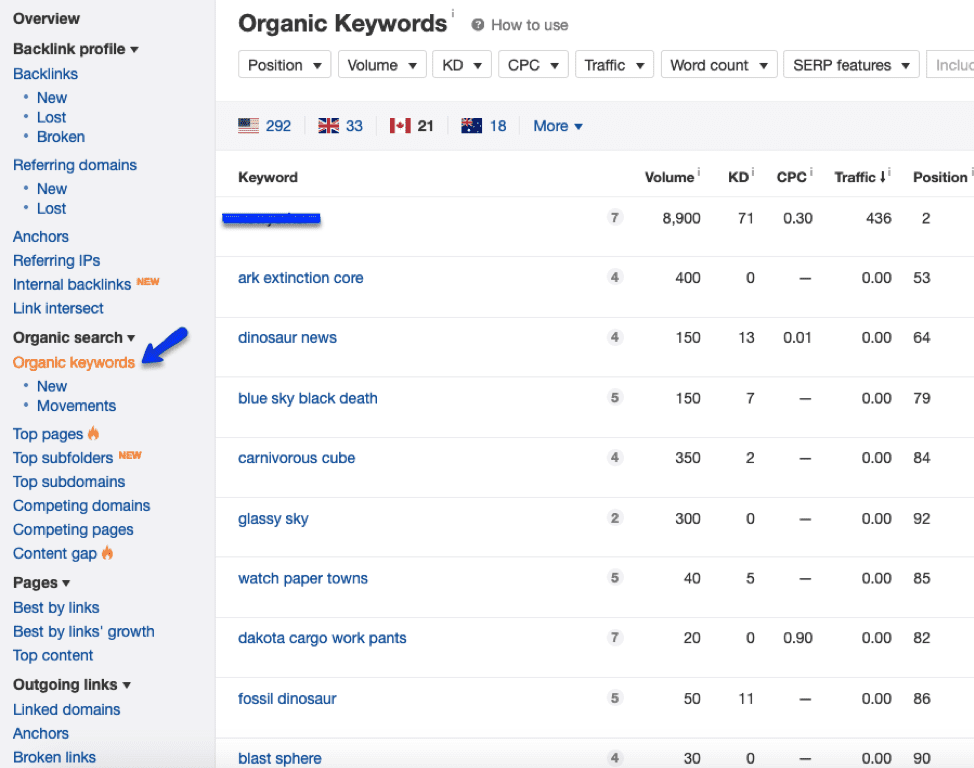
In this section, you will find a list of keywords pulled from your competitor’s URL and how they rank on Google. What you are looking to find are keywords with a "good" volume score - higher is usually better.
A high volume score means more demand. With that said, there are also a lot of keywords with low volume scores that, when combined, add up to strong traffic.
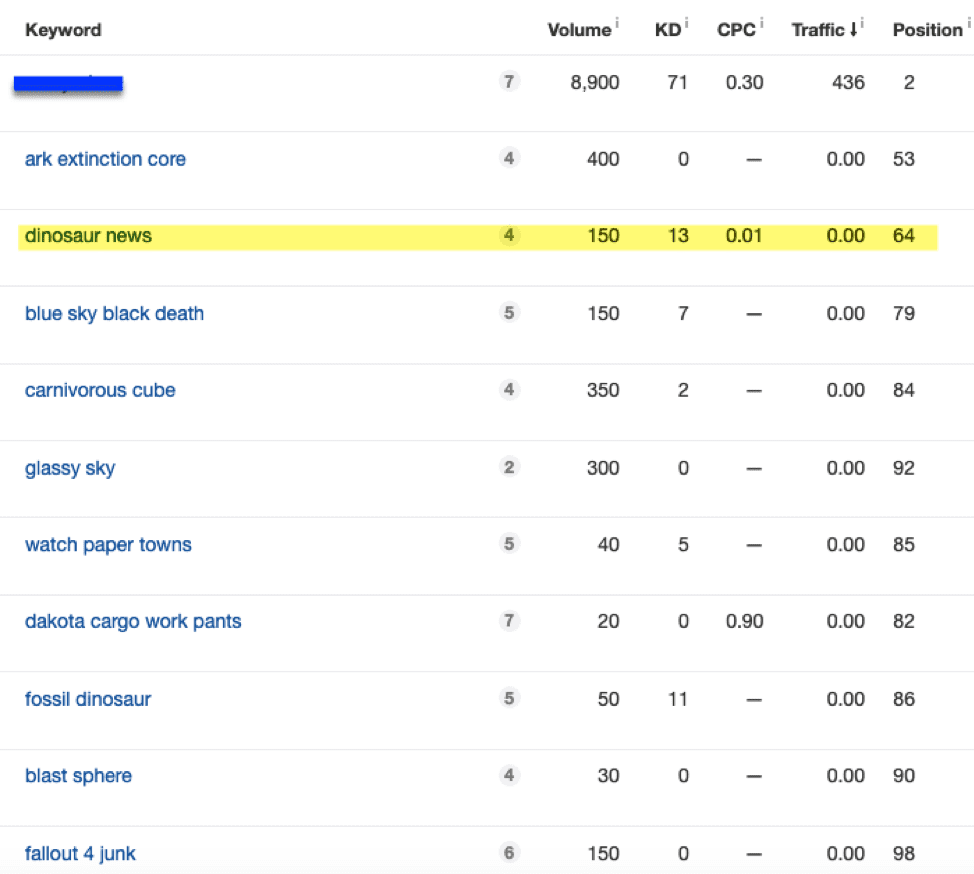
As shown in this example, the search volume for "dinosaur news" is relatively high, which is a keyword phrase you may want to use.
You may notice that there are a couple of keywords where the search volume numbers are not quite high enough, but when added together, the number increases. Making them available keywords.
Depending on the topic and competitor you are trying to rank higher than on Google, will determine how many keywords are listed.
Merely seeing the keywords can instantly cause tons of ideas to pop into your head that you will want to write about. But before doing anything, let’s take your keyword research up a level by filtering them first.
Playing with filters will provide you with more data. However, before you begin, there are a few items you must consider.
- Your website ranking capability
- The authority of your website
Knowing this information will determine what type of keywords to target. If your company’s blog site is brand new, you will want to target long-tail keywords. The more your site grows using evergreen content, the different filters you will want to play with inside the Ahrefs tool over time.
If your site is authoritative - relative to the competitor you are analyzing - then you can target more competitive keywords. For instance, targeting keywords in the search volume range of one-hundred to one-thousand is typically an excellent place to start, especially if your website is new.
This example shows where the filters are located inside the Ahrefs tool.

When you hover your mouse over each of the feature’s titles, a description box will appear that includes information about what that specific feature entails. You will also want to fiddle with the "Words," and "Position" filters. These are helpful if you're going to search only for long-tail keywords for instance and to learn where your competitor ranks on Google.
The next step is to leverage keywords using Ahrefs, "Keywords explorer."
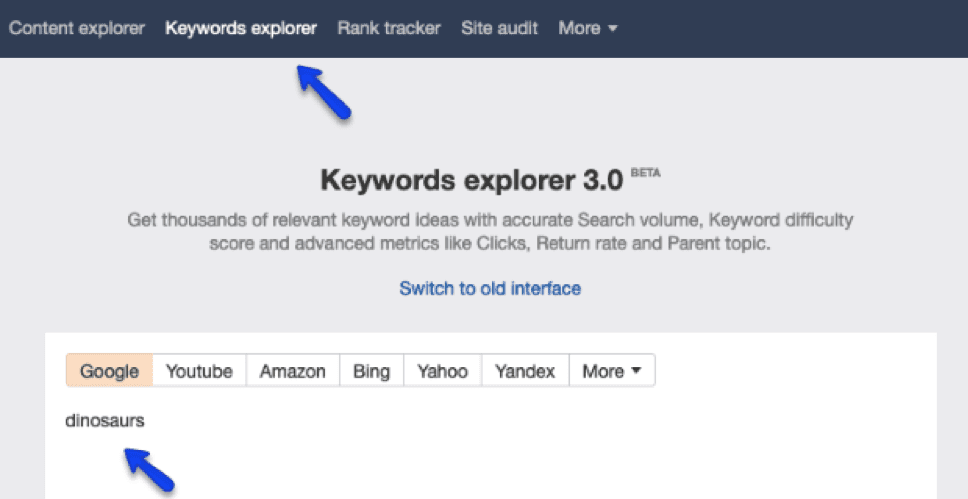
In this section, add your own keywords. Let the tool analyze them to see how well they are performing. Once the analysis is complete, Ahrefs will display all kinds of data about the keywords.
At this point, your goal is to search and identify more keyword ideas. To achieve this, scroll down to the "Keyword ideas" section.
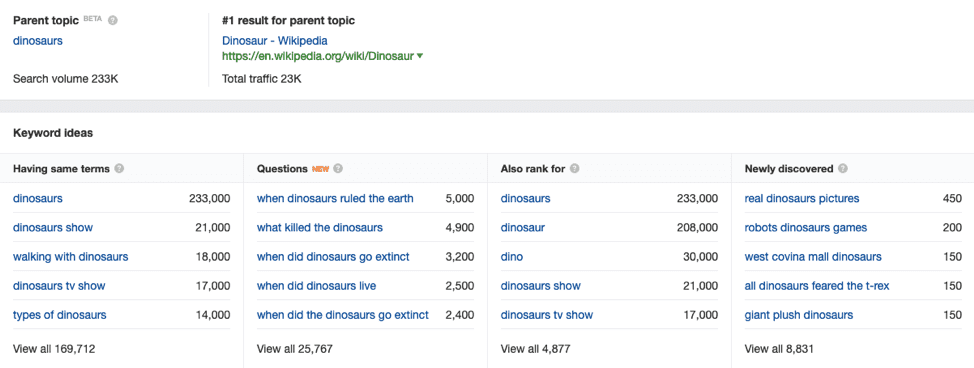
You will see a list of keyword ideas, similar to this example, above. Each is related to the original keyword. How you leverage these keyword ideas will mostly depend on the newness or authority of your company’s website.
Now, you will want to validate each keyword idea to narrow down your list. Each of the keywords will go through a vetting process to find the best set of keywords to use.
To do this next step, simply go back to the "Keyword explorer" section and paste in the keyword idea. Use the one you found in your competitor search earlier, like the one we discovered, "dinosaur news."

First, look at the keyword difficulty to determine if it will be too hard to rank with on Google. Then take a look at the number of searches that result in a click.
Next, review the "Paid vs. Organic" results for your considered keyword phrase. This is important information because the more paid results there are, the more organic results will be pushed further down on the Search Engine Results Page.
Just like before, scroll down on this page to the "Keyword idea" section to see what words and sites are ranking.
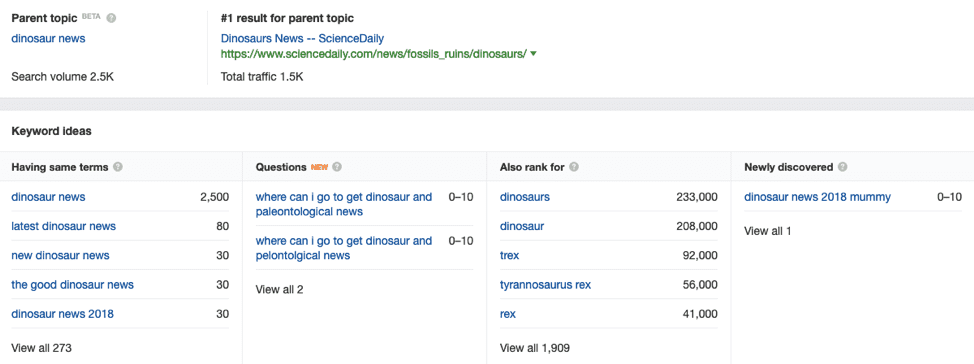
Use all of the metrics to decide whether or not your keyword(s) is worth using or not.
The overall outcome of your "Keyword research" needs to be that you are able to create an evergreen content page that has more value than the one that is currently ranking on Google.
5. How to use the keyword(s) inside your evergreen content
After completing your "Keyword research" and deciding on the keywords or phrase you are going to use, you need to know how to use them to your advantage.
- Include the chosen keyword(s) throughout your evergreen content. Make sure it is done naturally. Don't try to jam or force the keyword into a sentence where it does not belong, as this will be seen as "keyword stuffing" by Google.
- Be sure to write an SEO-friendly URL that includes the keyword(s).
- Include the keyword(s) in the page title and in at least one subheading. It will also need to be added in the title tag, meta description, and image alt tag.
- Add relevant inbound links to other pages on your website, as well as, outbound links that lead to resources and outside sources.
- It is recommended to link to at least three quality, relevant resources in every piece of content that you publish.
6. Maintaining your evergreen content
Although evergreen content does not expire, it can change. In fact, it should.
There are times when after publishing an evergreen blog post, you will learn of new information surrounding the topic. At which time, you should go back to the original blog post, update it, and then republish it.
Refrain from "setting and forgetting it." Your evergreen content can not only save you time on writing but can increase your company’s blog traffic. In 2019, it was found that updating and republishing old blog posts with new content and images can increase organic traffic by as much as 111.37%.
As your goal is to save time, not to waste it, you do not want to update every evergreen blog post, only the popular ones. Check your analytics to see which evergreen content performed well in the past and choose to update those ones.
Your company does not want to post average content that is hard to find, and it is why you need to implement useful evergreen content into your digital marketing strategy.
Leverage your blog posts with keywords that drive results. Make each blog page count, by writing evergreen content that will rank on Google, bring visitors to your site, and turn your readers into buying customers.
Drew Hendricks is the Organic Growth Marketing Manager at
Nextiva. Drew has also written for many major publishers such as Forbes, Entrepreneur Magazine and The Huffington Post. He's also worked with a variety of different startups around the globe as well as larger advertising agencies in the United States and the UK.















